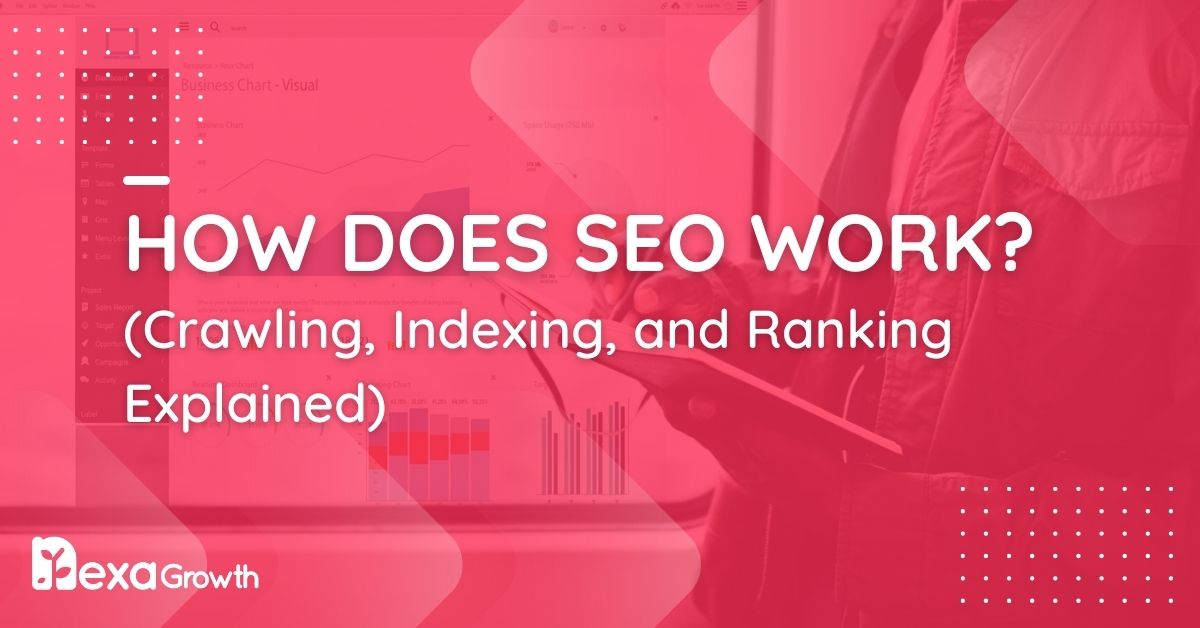- SEO works through three main steps: crawling, indexing, and ranking.
- Crawling is when search engine bots discover new web pages.
- Indexing is the process of a search engine storing and organizing this content.
- Ranking is when the search engine determines the relevance and authority of a page for a user’s query.
- A successful SEO strategy requires a combination of On-Page, Off-Page, and Technical SEO.
If you want people to find your business online, SEO (Search Engine Optimization) is a must.
With 93% of web traffic coming from search engines, ranking well can mean the difference between being seen or getting lost in the crowd.
SEO helps your website show up when people search for what you offer. It drives free, organic traffic and builds trust with your audience—no ads required. The better your SEO, the more chances you have to reach the right people.
So how does it work? This guide covers the basics—how search engines crawl, index, and rank pages—plus the best strategies for staying ahead in 2026. Whether you’re new to SEO or looking to improve, you’ll find everything you need right here.
💡 Ready to take your SEO knowledge to the next level? Let’s dive in and uncover how does SEO work, why it’s essential, and how to make it work for your business.
Boost Your Rankings With Nexa Growth!
Get expert SEO strategies that drive traffic, increase visibility, and grow your business—let’s get you to the top!
Contact UsWhat Is SEO and How Does It Work?
Search Engine Optimization (SEO) is the process of enhancing a website’s visibility in search engine results to attract more organic (unpaid) traffic.
In simple terms, SEO helps search engines understand your website’s content and rank it higher when people search for related topics or keywords.
Imagine it as creating a digital map that guides search engines to your website, ensuring it’s easy to find and appealing to visitors.
SEO relies on three primary steps: crawling, indexing, and ranking. Each stage plays a critical role in determining how search engines discover, organize, and prioritize content.
Crawling: Discovering Content
Crawling is the first step in SEO, where search engine bots, known as “spiders” or “crawlers,” explore the internet to find new and updated content. These bots scan links, text, images, and other data across web pages.
Real-World Analogy: Think of crawlers as librarians searching the entire library for new books and cataloging them for readers.
How It Works:
- Crawlers start by visiting known web pages and follow the links to discover additional pages.
- They scan URLs, HTML code, and content, collecting data for indexing.
Optimization Tips:
- Use an XML sitemap to guide crawlers to your website’s key pages.
- Ensure important pages aren’t blocked by your robots.txt file.
- Fix broken links and avoid orphaned pages.
💡 External Resource: Learn about crawl budgets and how to optimize them.
Indexing: Storing and Organizing Content
Once crawlers discover a page, the content is stored and organized in the search engine’s database, known as the index. This database acts as a massive digital library where all the discovered content is categorized based on relevance.
- What Happens During Indexing:
- Search engines analyze the page’s content, including keywords, headings, meta tags, and multimedia.
- Pages that lack unique content or are flagged with “noindex” tags won’t make it into the index.
- What Search Engines Evaluate During Indexing:
- Keywords: Relevance to specific search queries.
- Meta Tags: Titles and descriptions that summarize the content.
- Structured Data: Schema markup that helps search engines understand content context.
💡 Pro Tip: Use Google Search Console to monitor indexing issues and submit your sitemap.
- Optimization Tips:
- Use concise and keyword-rich meta titles and descriptions.
- Avoid duplicate content, as it confuses search engines.
- Use structured data to enhance visibility in rich results.
💡 External Resource: Check out Google’s SEO best practices.
Ranking: Delivering Relevant Results
Ranking is the final stage where search engines evaluate indexed pages to determine their relevance for a user’s query. The most relevant and authoritative pages are displayed at the top of search engine results pages (SERPs).
- Real-World Analogy: It’s like a librarian recommending the best book based on what you’re searching for.
- Factors That Influence Rankings:
- Content Quality: Is the content valuable and aligned with the search intent?
- Backlinks: Are other reputable sites linking to the page?
- User Experience: Does the site load quickly, is it secure, and is it mobile-friendly?
- Key Algorithms to Know:
- RankBrain: Google’s AI-based algorithm that interprets search intent and adjusts rankings based on user behavior.
- Helpful Content Update: Focuses on prioritizing high-quality, user-first content over content designed solely for search engines.
- Page Experience Signals: Includes metrics like Core Web Vitals (loading speed, interactivity, and visual stability), mobile-friendliness, and HTTPS security.
- Optimization Tips:
- Publish content that satisfies user intent and provides actionable insights.
- Focus on earning high-quality backlinks to boost authority.
- Improve site speed, mobile responsiveness, and security.
💡 External Resource: Learn more about how Google ranks content.
Bringing It All Together
By understanding these three stages—crawling, indexing, and ranking—businesses can create content that is both accessible to search engines and highly valuable to users.
The Three Pillars of SEO: On-Page, Off-Page, and Technical
To master SEO, you need to focus on its three main pillars: on-page SEO, off-page SEO, and technical SEO.
Each plays a critical role in ensuring your website ranks higher on search engine results pages (SERPs) and provides a seamless experience for users.
Let’s break them down and explore actionable tips to optimize each pillar.
-
On-Page SEO: Optimizing Content and Keywords
On-page SEO involves optimizing the elements within your website to improve its search visibility and user experience. The goal is to ensure your content is relevant, high-quality, and aligned with user intent.
- Key Components:
- Content Quality: Focus on creating unique, valuable, and well-structured content that answers users’ queries.
- Keyword Optimization: Use targeted keywords naturally in headings, body text, and URLs without overstuffing.
- Meta Tags: Write compelling meta titles and descriptions to improve click-through rates (CTR).
- Internal Linking: Link related pages on your site to improve navigation and distribute link equity.
- Actionable Tips:
- Use tools like Yoast SEO or Rank Math to analyze on-page SEO elements.
- Write concise, engaging meta titles under 60 characters and descriptions under 160 characters.
- Use semantic keywords to strengthen content relevance.
- Key Components:
-
Off-Page SEO: Building Authority and Trust
Off-page SEO focuses on activities outside your website to build authority and credibility. It primarily revolves around earning high-quality backlinks, which signal to search engines that your website is trustworthy and relevant.
- Key Components:
- Backlinks: Secure links from authoritative websites.
- Brand Mentions: Build brand awareness through mentions on blogs, forums, and social media.
- Social Signals: Boost engagement on platforms like LinkedIn, Facebook, and Twitter.
- Actionable Tips:
- Use tools like Ahrefs or SEMrush to analyze your competitors’ backlinks and identify opportunities.
- Create shareable content like infographics, case studies, or industry reports.
- Engage in guest blogging on reputable websites to gain visibility and backlinks.
💡 External Resource: Explore Ahrefs’ backlink strategies to build strong links.
- Key Components:
-
Technical SEO: Optimizing Site Performance
Technical SEO focuses on improving the backend of your website to ensure it’s fast, accessible, and easy for search engines to crawl and index. Without strong technical SEO, even the best content can struggle to rank.
- Key Components:
- Site Speed: Faster websites improve user experience and rankings.
- Mobile Optimization: Ensure your site is mobile-friendly as Google uses mobile-first indexing.
- Structured Data: Implement schema markup to help search engines understand your content.
- Core Web Vitals: Focus on loading performance, interactivity, and visual stability.
- Actionable Tips:
- Use tools like Google PageSpeed Insights to identify and fix speed issues.
- Test your site’s mobile-friendliness with Google’s Mobile-Friendly Test.
- Add structured data using tools like Schema.org or Google’s Structured Data Markup Helper.
- Monitor Core Web Vitals in Google Search Console and prioritize fixes.
💡 External Resource: Dive deeper into Google’s Core Web Vitals guide.
- Key Components:
Nexa Growth-Your One-Stop SEO Solution!
From rankings to traffic and conversions, we’ve got all your SEO needs covered—let’s grow your business together!
Contact UsHow These Pillars Work Together
On-page, off-page, and technical SEO are interconnected and must work in harmony to achieve the best results.
For example, technical SEO ensures your site is crawlable and fast, on-page SEO optimizes your content for relevance, and off-page SEO builds trust and authority. Ignoring any one pillar can weaken your overall strategy.
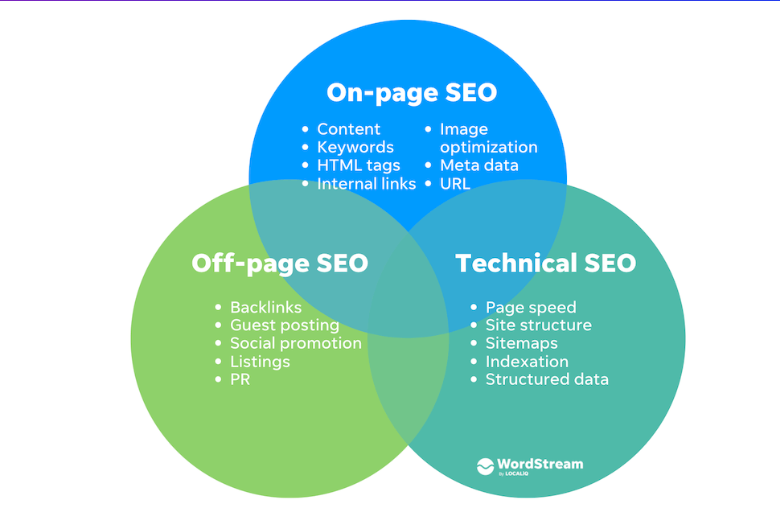
The Role of Search Engines in SEO
Search engines like Google, Bing, and Yahoo serve as digital gatekeepers, connecting users to the information they seek.
For businesses, understanding how search engines work is critical to optimizing their websites and driving traffic.
The process behind search engine operations can be broken into three key stages: crawling, indexing, and ranking. Mastering these can help your website climb the search results and drive more traffic your way.
Tools for Monitoring Search Engine Performance
To optimize your website for search engines, you need the right tools. These help you track performance, fix issues, and refine your SEO strategy.
-
Google Search Console
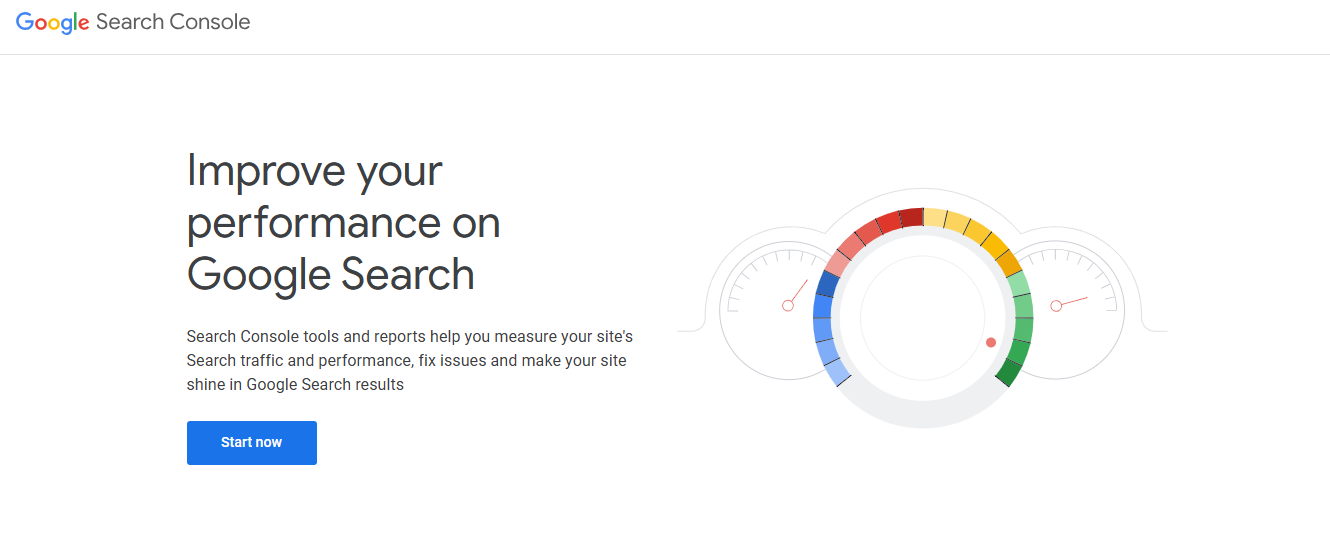
Google Search Console’s Webpage Google Search Console is a must-have for any website owner. It helps you:
- Monitor indexing issues to ensure search engines can properly list your pages.
- Track crawl activity to see how Google navigates your site.
- Analyze search performance, including clicks, impressions, and rankings.
-
Ahrefs
-
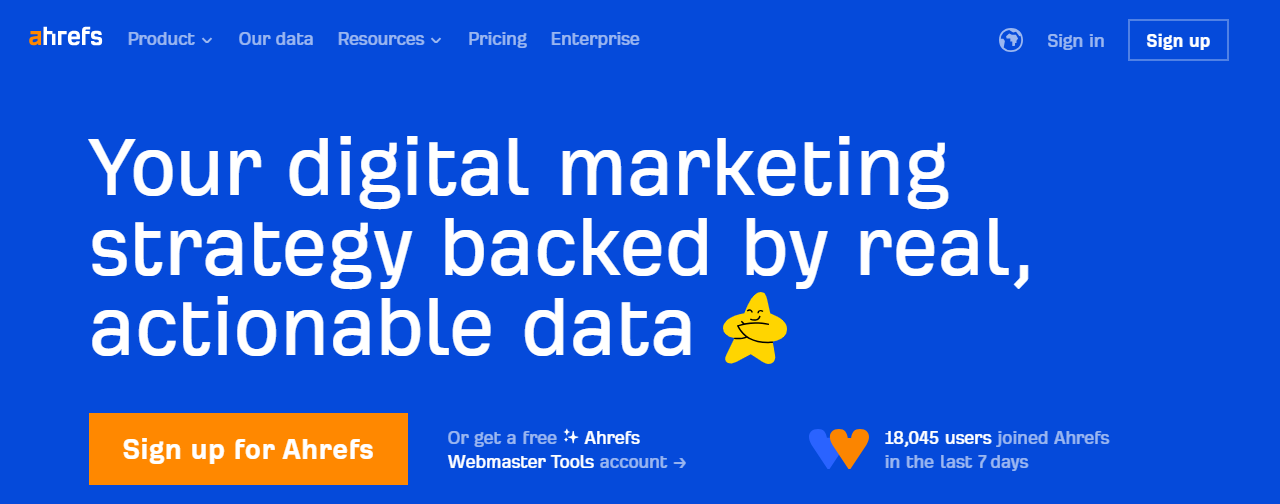
Ahref’s Webpage
Ahrefs is a powerful tool for understanding your website’s authority and SEO health. It helps you:
- Analyze backlinks to see who’s linking to your site.
- Research competitor strategies to find opportunities for growth.
- Track keyword rankings and see where you stand in search results.
-
-
Semrush
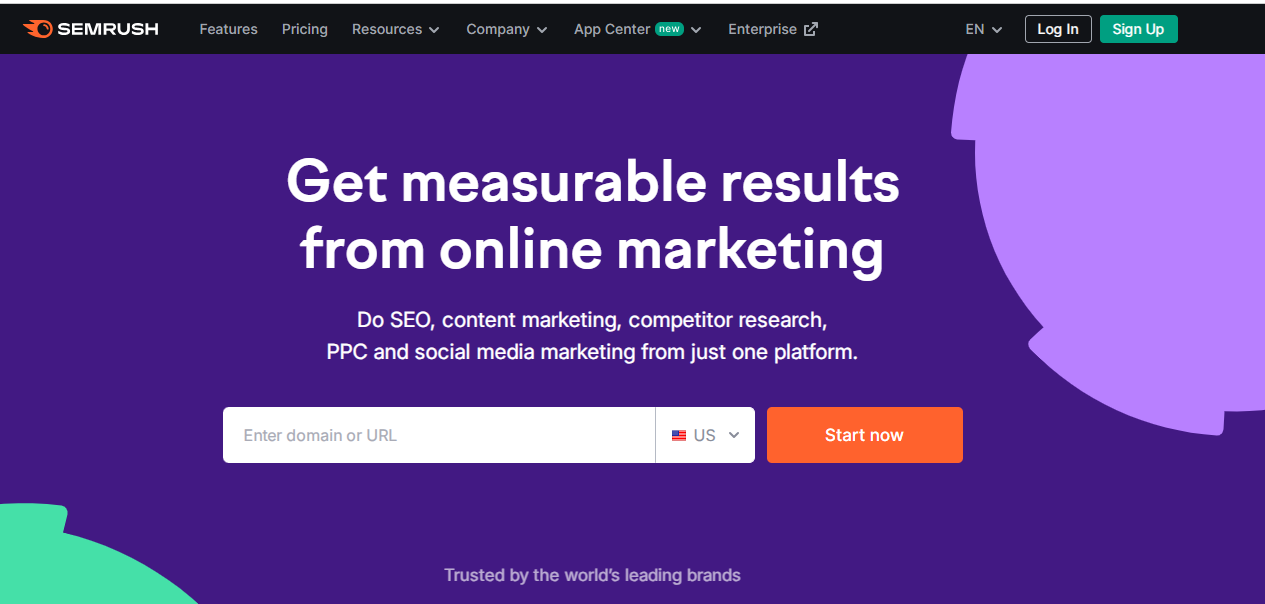
Semrush’s Webpage Semrush is a comprehensive SEO and marketing tool that provides:
- Keyword research to help you find the best terms to target.
- Site audits to identify technical issues affecting your rankings.
- Competitive analysis to see how your site stacks up against others in your industry.
Using these tools effectively can help you improve visibility, attract more visitors, and stay ahead of the competition.
Why Understanding Search Engines Matters
By grasping how search engines crawl, index, and rank content, you can align your website with their priorities, improving your chances of ranking higher and reaching your audience.
Staying informed about updates like RankBrain and Core Web Vitals helps you adapt and stay competitive in the ever-changing SEO landscape.
Paid Search vs. Organic Search: What’s the Difference?
When it comes to driving traffic to your website, businesses can leverage two powerful strategies: paid search (PPC) and organic search (SEO).
While both approaches aim to improve visibility on search engine results pages (SERPs), they differ significantly in terms of cost, strategy, and long-term benefits.
What is Paid Search (PPC)?
Paid search involves running ads on platforms like Google Ads or Bing Ads, where businesses bid on keywords to have their ads displayed at the top of SERPs.
- Pros:
- Instant visibility and traffic.
- Flexible targeting options (location, demographics, device).
- Precise ROI tracking through ad platforms.
- Cons:
- Costs can be high for competitive keywords.
- Traffic stops when the budget runs out.
- Lower click-through rates (CTR) compared to organic results.
What is Organic Search (SEO)?
Organic search is the process of optimizing your website to rank higher on SERPs naturally, without paying for ad placements. SEO focuses on improving content, website structure, and authority to attract traffic over time.
- Pros:
- Cost-effective with a higher long-term ROI.
- Builds trust and credibility as users prefer organic results.
- Sustainable traffic even without continuous investment.
- Cons:
- Takes time (3-6 months or more) to show results.
- Requires continuous effort to maintain rankings.
- Dependent on search engine algorithms, which change over time.
Which Approach Should You Choose?
Both paid search and organic SEO have their place in a digital marketing strategy:
- Use PPC for immediate visibility, product launches, or seasonal promotions.
- Invest in SEO for sustainable, long-term traffic and credibility.
- A balanced approach—combining PPC for short-term goals and SEO for long-term growth—is often the most effective.
Why SEO Delivers Long-Term ROI
While PPC provides quick results, its benefits are short-lived as traffic stops once the ads are paused.
SEO, on the other hand, builds a foundation for ongoing visibility and trust. Optimized content and strong backlinks can keep generating traffic for years, making SEO a valuable long-term investment.
Components of an Effective SEO Strategy
Creating an effective SEO strategy requires a combination of technical know-how, creativity, and ongoing analysis.
Below, we break down the key components of a successful strategy and provide a step-by-step guide to help beginners get started.
-
Keyword Research: The Foundation of SEO
Keyword research helps identify the search terms your audience is using, enabling you to create content that matches their intent.
- Tools to Use:
- Google Keyword Planner: Great for finding keyword ideas based on search volume and competition.
- Ahrefs: Offers in-depth keyword difficulty analysis, search volume trends, and competitor insights.
- AnswerThePublic: Discover the questions and queries people are searching for.
- Pro Tip: Focus on long-tail keywords (e.g., “best SEO tools for small businesses”) as they are less competitive and often align closely with user intent.
- Tools to Use:
-
Content Creation: Targeting User Intent
Content is the backbone of any SEO strategy. Search engines prioritize high-quality, value-driven content that satisfies user intent.
- How to Create Effective Content:
- Research your audience’s pain points and interests.
- Use engaging headlines and subheadings that incorporate target keywords.
- Include multimedia like images, infographics, and videos to enhance engagement.
- Optimize meta tags, alt text, and readability for SEO.
- Pro Tip: Use tools like Surfer SEO to create content optimized for search engines.
💡 External Resource: Explore HubSpot’s guide to content creation for beginners.
- How to Create Effective Content:
-
Link Building: Building Authority and Trust
Backlinks from authoritative websites signal to search engines that your site is trustworthy and valuable.
- How to Build Backlinks:
- Create shareable assets like infographics, case studies, or industry reports.
- Leverage guest blogging to reach new audiences and earn links.
- Use tools like Ahrefs or SEMrush to analyze competitors’ backlinks and identify opportunities.
- Pro Tip: Focus on earning backlinks from niche-relevant and high-authority websites to maximize impact.
💡 External Resource: Check out Ahrefs’ guide to link building strategies for more insights.
- How to Build Backlinks:
-
User Experience (UX): Optimizing for Engagement
User experience plays a significant role in SEO, as search engines prioritize sites that are fast, mobile-friendly, and easy to navigate.
- Key Factors to Optimize:
- Site Speed: Use tools like Google PageSpeed Insights to identify and fix performance issues.
- Mobile Responsiveness: Ensure your site is fully optimized for mobile users, as Google uses mobile-first indexing.
- Navigation: Use clear menus and internal links to help users find what they need quickly.
- Key Factors to Optimize:
-
Analytics and Measurement: Tracking Success
SEO is an ongoing process, and regular analysis is crucial to refining your strategy.
- Tools to Track SEO Performance:
- Google Analytics: Monitor traffic, bounce rates, and session duration.
- Google Search Console: Identify indexing issues, keyword performance, and crawl errors.
- SEMrush: Track keyword rankings, backlinks, and competitor performance.
- Pro Tip: Create custom dashboards in Google Data Studio to visualize your progress over time.
- Tools to Track SEO Performance:
Step-by-Step Guide to Create Your SEO Strategy
- Set Clear Goals: Define your objectives, such as increasing traffic, improving rankings, or boosting conversions.
- Conduct Keyword Research: Identify high-value keywords your target audience is searching for.
- Optimize Your Website: Ensure your site is technically sound with fast load times, mobile-friendliness, and proper meta tags.
- Create High-Quality Content: Develop content that addresses user intent and incorporates target keywords.
- Build Backlinks: Reach out to industry websites and create link-worthy content.
- Monitor Performance: Use tools like Google Analytics and Search Console to track your rankings, traffic, and engagement.
- Refine Your Strategy: Regularly update outdated content, fix technical issues, and adapt to algorithm changes.
Why These Components Are Essential
A successful SEO strategy is like a well-oiled machine, with each component playing a vital role in driving organic traffic and building credibility. From researching keywords to tracking results, every step contributes to long-term success.
SEO Tools You Need to Succeed
The right tools can make or break your SEO strategy. From keyword research to technical audits, SEO tools provide the insights and data you need to improve your website’s visibility and performance.
Here’s a list of essential free and paid tools to help you succeed in SEO.
-
Ahrefs (Paid)
Ahrefs is one of the most comprehensive SEO tools available. It helps with backlink analysis, keyword research, competitor analysis, and site audits.
- Key Features:
- Analyze competitors’ backlinks and top-performing pages.
- Discover high-traffic keywords with low competition.
- Track keyword rankings and organic search performance.
- Key Features:
-
Google Analytics (Free)
Google Analytics is a must-have tool for tracking website traffic and user behavior. It provides in-depth insights into how visitors interact with your site.
- Key Features:
- Monitor page views, bounce rates, and session duration.
- Track traffic sources (organic, paid, social).
- Set up conversion goals to measure ROI.
- Key Features:
-
Screaming Frog (Free & Paid)
Screaming Frog SEO Spider is a desktop tool designed for technical SEO audits. It crawls websites to identify issues like broken links, duplicate content, and missing metadata.
- Key Features:
- Crawl up to 500 URLs for free.
- Analyze site structure and identify technical errors.
- Generate XML sitemaps for search engines.
- Key Features:
-
Yoast SEO (Free & Paid)
Yoast SEO is a popular WordPress plugin that helps optimize your content for search engines. It’s beginner-friendly and offers clear recommendations.
- Key Features:
- Optimize meta titles, descriptions, and headings.
- Analyze readability and keyword usage.
- Generate XML sitemaps automatically.
- Key Features:
SEO Tools Summary Table
| Tool | Purpose | Free/Paid |
|---|---|---|
| Ahrefs | Backlink analysis, keyword research, site audits | Paid |
| Google Analytics | Traffic and user behavior tracking | Free |
| Screaming Frog | Technical SEO audits | Free & Paid |
| Yoast SEO | On-page SEO optimization | Free & Paid |
Why These Tools Matter
Each tool serves a unique purpose, from improving your content and tracking performance to fixing technical issues and analyzing backlinks. By combining these tools, you’ll have everything you need to create and refine an effective SEO strategy.
AI and SEO: The Future of Optimization
Artificial Intelligence (AI) is revolutionizing the world of SEO, transforming how search engines interpret content and how marketers optimize for search.
AI tools and algorithms are paving the way for more personalized, accurate, and efficient search engine experiences, making it essential for businesses to adapt to this evolving landscape.
How AI is Changing SEO
- AI-Powered Tools for Content Creation
AI tools like ChatGPT, Jasper, and Frase.io are redefining content creation by generating high-quality, SEO-optimized content faster than ever.
- Benefits for SEO:
- Quickly create content tailored to specific keywords and user intent.
- Use AI tools to identify content gaps and generate topic ideas.
- Optimize for readability and tone, ensuring a better user experience.
- Pro Tip: Use AI for content ideation, but always review and refine to maintain originality and credibility.
- Google’s AI Algorithms: BERT and MUM
Google’s AI-driven algorithms are reshaping how search engines understand and rank content.
- BERT (Bidirectional Encoder Representations from Transformers): Focuses on understanding the context of words in a sentence to better match user intent.
- MUM (Multitask Unified Model): A more advanced AI that can process information across languages and media to deliver richer, more contextual search results.
- Impact on SEO:
- Prioritizes user-centric, conversational content.
- Rewards in-depth and contextually relevant answers over keyword-stuffed pages.
- The Rise of Personalized Search
AI enables search engines to deliver personalized results based on user behavior, location, and preferences.
- Trends to Watch:
- Increased focus on local SEO as search engines prioritize “near me” queries.
- AI-driven SERP features like “People Also Ask,” voice search, and rich snippets.
- Optimization Tips:
- Use structured data (schema markup) to enhance visibility in AI-driven SERPs.
- Optimize for voice search by using long-tail, conversational keywords.
Predicted Trends in AI and SEO
- AI-Powered Search Engine Results Pages (SERPs)
Search engines are likely to integrate more AI-driven features, such as multimedia-rich results and interactive snippets, giving users answers directly within the SERP. - AI for Technical SEO
Tools like Screaming Frog and Deepcrawl are incorporating AI to identify technical issues and suggest advanced fixes, streamlining site audits. - Hyper-Personalization
AI will further refine how search engines customize results for individual users, forcing marketers to create more targeted, audience-specific strategies.
Why AI Matters for SEO
AI is no longer a futuristic concept—it’s the driving force behind modern search engines and SEO tools. Businesses that embrace AI-powered strategies will gain a competitive edge by improving user experiences, understanding search intent, and delivering optimized content.
Common SEO Mistakes to Avoid
Even the most well-intentioned SEO strategies can go awry if common mistakes are overlooked.
Avoiding these errors is key to ensuring your website ranks well and provides an excellent user experience. Here are some of the most common SEO mistakes and actionable tips to fix them.
-
Keyword Stuffing
The Mistake: Overloading a page with keywords in an unnatural way in an attempt to rank higher. This not only leads to poor readability but also results in penalties from search engines.
- Fix: Focus on keyword placement, not repetition. Use keywords naturally in headings, body content, and meta tags. Incorporate LSI (Latent Semantic Indexing) keywords to add context.
-
Ignoring Mobile-First Indexing
The Mistake: Neglecting to optimize your website for mobile users. Since Google uses mobile-first indexing, a non-mobile-friendly site will struggle to rank.
- Fix: Ensure your site is responsive, with content that adjusts seamlessly to mobile devices. Use Google’s Mobile-Friendly Test to evaluate your site’s performance on mobile.
-
Poor-Quality Backlinks
The Mistake: Building backlinks from low-quality or spammy websites. Such backlinks harm your domain authority and can lead to penalties.
- Fix: Focus on earning backlinks from authoritative, niche-relevant websites. Regularly audit your backlink profile using tools like Ahrefs or SEMrush and disavow toxic links.
-
Neglecting Technical SEO
The Mistake: Overlooking crucial technical aspects like site speed, crawl errors, and structured data. Without strong technical SEO, even the best content may not rank.
- Fix:
- Improve site speed using tools like Google PageSpeed Insights.
- Regularly check for crawl errors in Google Search Console.
- Add schema markup to help search engines understand your content.
💡 Tip: Tools like Screaming Frog can help identify and fix technical issues.
- Fix:
How to Avoid These Mistakes
- Adopt a Holistic Approach: Address all aspects of SEO—on-page, off-page, and technical.
- Stay Updated: Follow trusted sources like Search Engine Journal and Google’s Webmaster Blog for the latest updates.
- Monitor Regularly: Use tools like Google Analytics and Search Console to track progress and identify problems.
How to Measure SEO Success
Measuring the success of your SEO efforts is essential for refining your strategy and achieving long-term growth.
By tracking the right metrics, you can assess what’s working, identify areas for improvement, and ensure your efforts align with your business goals.
Here are the key metrics to measure SEO success and how to monitor them effectively.
-
Organic Traffic
What It Measures: The number of visitors who find your website through unpaid search results.
- Why It’s Important: Organic traffic indicates how well your website is ranking for targeted keywords and attracting users.
- How to Measure: Use Google Analytics to monitor organic traffic trends over time. Compare traffic growth to your SEO efforts, such as content updates or new backlinks.
-
Keyword Rankings
What It Measures: The position of your website in search engine results pages (SERPs) for specific keywords.
- Why It’s Important: Higher rankings for relevant keywords increase visibility and drive targeted traffic.
- How to Measure: Tools like Ahrefs or SEMrush allow you to track keyword rankings and identify changes over time.
-
Bounce Rate and Session Duration
What They Measure:
- Bounce Rate: The percentage of visitors who leave your site after viewing only one page.
- Session Duration: The average time users spend on your site.
- Why They’re Important: A high bounce rate and low session duration may indicate that your content isn’t engaging or relevant.
- How to Measure: Use Google Analytics to analyze bounce rates and session durations for individual pages.
-
Conversion Rates
What It Measures: The percentage of visitors who complete a desired action, such as filling out a form or making a purchase.
- Why It’s Important: Conversion rates reflect how well your SEO strategy aligns with your business objectives.
- How to Measure: Set up conversion goals in Google Analytics to track user actions like form submissions, downloads, or purchases.
Using Tools to Monitor SEO Success
- Google Analytics: Tracks traffic, user behavior, and conversions.
- Google Search Console: Monitors keyword performance, indexing issues, and click-through rates (CTR).
- Looker Studio: Combines data from multiple sources to create customizable performance dashboards.
- Ahrefs and SEMrush: Provide advanced insights into rankings, backlinks, and traffic trends.
Why Measuring SEO Success Matters
By regularly analyzing these metrics, you can ensure that your SEO strategy delivers tangible results. Monitoring data allows you to make informed decisions, adjust your tactics, and stay ahead of the competition.
Conclusion
SEO is not just a marketing tactic; it’s a cornerstone for achieving long-term online success. By understanding and implementing the key aspects of SEO—such as keyword research, quality content creation, link building, and technical optimization—you can build a strong foundation for your website to thrive in search engine rankings.
Throughout this guide, we’ve explored how search engines work, the importance of SEO, and the tools and strategies you need to succeed. It’s clear that SEO is a continuous journey, not a one-time fix. Search engines constantly evolve their algorithms, introducing new challenges and opportunities for businesses. Staying informed, monitoring key metrics, and adapting your strategies to industry trends are essential to maintaining visibility and staying ahead of competitors.
Investing in SEO means investing in the future of your business. It provides sustainable growth, builds trust with your audience, and delivers a high return on investment over time. Whether you’re optimizing for crawling and indexing, creating user-focused content, or leveraging AI tools, every effort you make contributes to long-term results.
Maximize Your SEO Potential with Nexa Growth!
Get expert-driven SEO strategies tailored to boost your rankings, drive traffic, and grow your business—let’s make your website unstoppable!
Contact UsFAQs
SEO can often feel complex, especially for beginners. Here are answers to some of the most frequently asked questions about SEO, broken down into actionable insights to help you navigate your optimization journey.
1. How long does it take for SEO to work?
SEO is a long-term strategy. You can expect to see initial results within 3 to 6 months, depending on factors like competition, keyword difficulty, and the state of your website. However, significant improvements in traffic and rankings often take 6 to 12 months.
2. Can I do SEO myself?
Yes, you can start SEO yourself by learning the basics and using free tools like Google Analytics and Google Search Console. However, mastering SEO’s technical aspects and advanced strategies often requires experience and time.
3. How does SEO compare to SEM?
SEO focuses on improving organic traffic through unpaid strategies like keyword optimization and content creation. SEM (Search Engine Marketing), on the other hand, involves paid search strategies like Google Ads.
Key Differences:
SEO: Long-term strategy, cost-effective, builds credibility.
SEM: Short-term visibility, requires ongoing ad spend.
4. What’s the cost of SEO?
SEO costs vary depending on your goals, competition, and the agency or professional you hire. Small businesses may spend anywhere from £500 to £2,000 per month, while larger enterprises may require more comprehensive plans.

